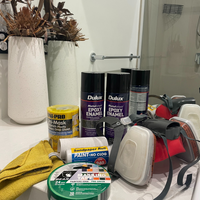- Subscribe to RSS Feed
- Mark as New
- Mark as Read
- Bookmark
- Subscribe
- Printer Friendly Page
- Report Inappropriate Content
Difficulty: Beginner
Spray painting tapware can be an easy and cost-efficient way of giving your bathroom a fresh new look.
Here is a simple guide to spray painting a tap. Please follow all safety guidelines provided by manufacturers and use the recommended protective gear, including a safety mask and goggles. Ensure you are painting in a well-ventilated area.
Video Tutorial
Steps
Step 1
1/5Sand the tap.
Use the 240-grit sandpaper to sand your tap thoroughly. It’s a good idea to wear safety glasses before sanding. Take care not to scratch your sink or cabinet. Sanding removes any dirt or oils and ensures a clean and long-lasting finish.
Use a damp corner of a cloth to wipe away any dust or debris that may have resulted from the sanding.
Wipe the tap dry before proceeding.




Step 2
2/5Apply masking tape.
Carefully apply masking tape around the tap to prevent paint from falling on the surrounding areas. Be precise and cover all the areas you don't want to paint.
You can use a plastic drop sheet to cover surfaces like the mirror, sink, and benchtop. These sheets provide good coverage and are easy to tape in place.

Step 3
3/5Paint the tap.
For added protection against paint splashes, position a cardboard box directly behind the area you are painting.
Wear your safety mask. Shake the paint can thoroughly.
Start spraying lightly so the paint coats the tap in thin layers. Spray all around the tap. This technique prevents paint drips and ensures a uniform look. Remember to spray the rear of the tap and underneath the spout.
Apply a thin first coat. Wait for at least two hours before applying a second coat.
Ensure the paint is completely dry before proceeding to the next step. You may have to wait for approximately four hours.
Step 4
4/5Remove the drop sheet and the masking tape.
Once the paint on your tap has dried, carefully remove the sheet and the masking tape.
Check thoroughly for any bits of tape you may have missed, especially around the base of the tap.
Step 5
5/5Clean the area.
Paint may have fallen on some areas around your tap, including those that were covered. Use mineral turpentine and a cloth to clean the excess paint.
Wipe the area dry.
You have now successfully painted your tap.

Materials
Tools
-
240-grit sandpaper
-
Plastic drop sheet
-
Your preferred spray paint, like Dulux 300g Metalshield Epoxy Enamel Gloss Spray Paint Structural Steel
-
Masking tape
-
Mineral turpentine
- Cardboard box.
- Cloth
- Personal protective equipment, including safety mask and glasses.
Images










You must be a registered Workshop community member to comment. Please join Workshop or sign in to join in the discussion.
Why join the Bunnings Workshop community?
Workshop is a friendly place to learn, get ideas and find inspiration for your home improvement projects
| Subject | Author | Posted | |
|---|---|---|---|
| February 2023 | |||
| August 2021 | |||
| a month ago | |||
| September 2022 | |||
| July 2021 |












